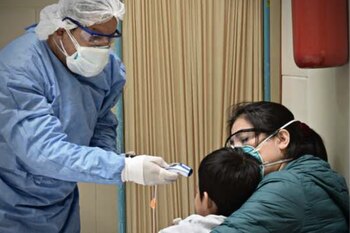
An alarming news came in the last few hours from Ucayali. Ninety children were reported to have been infected with the coxsackie virus. A number that rose rapidly because it is a highly contagious disease.
César Munayco, director of public health surveillance at Minsa's National Center for Epidemiology, Prevention and Disease Control (CDC), gave more details of this disease.
WHAT IS THE COXSACKIE?
It is an enterovirus that is quite common, and occurs in outbreaks, usually in young children, especially under five years of age. It is known as hand, foot and mouth disease. But Munayco explains that it is mild, and it is usually a picture that resolves in 7 to 10 days. A complication rarely occurs, but it could eventually lead to viral meningitis or encephalitis.
In some cases there may be dehydration, because infants have blisters in their mouths, cannot breastfeed. In that case, you should see the pediatrician. Few cases can be hospitalized.
IS IT CONTAGIOUS?
The expert explains that this is a contagious virus, it can practically be spread by direct contact from person to person through respiratory droplets. “When you talk, cough or sneeze, you can infect. Although the mask is present, it is also spread by being in contact with surfaces or objects contaminated with the virus,” he said.
It usually occurs in schools, because it is where there is the greatest contact between children. Now that is when face-to-face classes have restarted, that is when this outbreak has been seen.
COXSACKIE OUTBREAKS IN PERU
The director explains that we have previously had outbreaks in Peru of this virus. “We have had five previous events reported, and with this outbreak in Ucayali there are already six. In 2016, we had outbreaks in Piura, Junín, Cajamarca and southern Lima. Also in 2011 in Arequipa,” Munayco says.
He explained that the coxsackie virus has several subtypes such as A and B, and within the subtypes there are other viruses such as A16, which is the most common, and the one that usually occurs in outbreaks.
WHAT ARE THE SYMPTOMS?
The form in which the coxsackie presents itself, is similar to influenza, notes the specialist. It occurs with fevers, children have difficulty eating or drinking because of injuries and sore throat, there may be general malaise as well.
Sometimes papular lesions or blisters occur in the throat called herpangina, which makes the child unable to eat drinks or food. There may also be injuries to the palms of the hands and soles of the feet. As well as on elbows, buttocks in younger children. It appears as a rash that bothers the child.
RECOMMENDATIONS
Once the child has these symptoms, he or she must stay at home, not go to school. The doctor also recommends not to touch the lesions, because that is where the virus is located. “Adults can also be infected if they are in contact with injuries,” the expert explained.
If the child has injuries, you should take him to the doctor or pediatrician for evaluation and give the necessary recommendations.
TREATMENT
Treatments are symptomatic. If the child is dehydrated, he is given more fluids; if he cannot eat, he is given a line; if he has a fever, he is given acetaminophen.
CAN THERE BE CO-INFECTION WITH COVID-19?
Munayco points out that covid in children is much milder, and if they are vaccinated there is no problem. “So far we haven't seen any co-infection. Now that there are fewer cases, it is more difficult to detect them. There are cases of dengue with covid or influenza with covid, but we haven't seen it with coxsackie,” he said.
KEEP READING:
Últimas Noticias
Debanhi Escobar: they secured the motel where she was found lifeless in a cistern

The oldest person in the world died at the age of 119

Macabre find in CDMX: they left a body bagged and tied in a taxi
The eagles of America will face Manchester City in a duel of legends. Here are the details

Why is it good to bring dogs out to know the world when they are puppies




